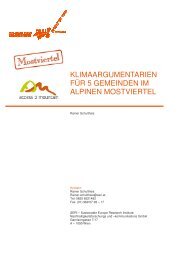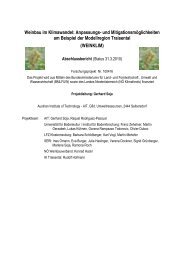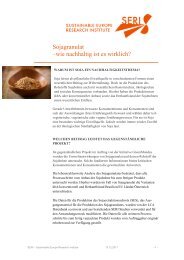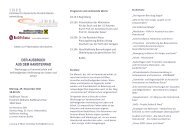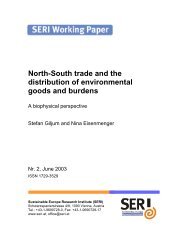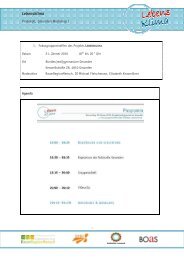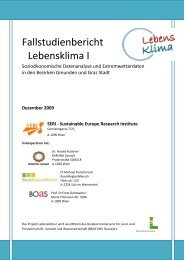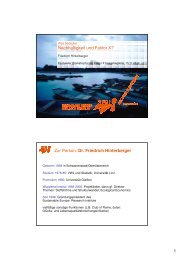Download PDF - Sustainable Europe Research Institute
Download PDF - Sustainable Europe Research Institute
Download PDF - Sustainable Europe Research Institute
Create successful ePaper yourself
Turn your PDF publications into a flip-book with our unique Google optimized e-Paper software.
SERI Working Paper No. 9<br />
Avoiding double counting. Resource use indicators should – to the extent possible – be additive<br />
across products, sectors and countries. Applying this principle restrictively, indicators could either<br />
reflect domestic environmental pressures related to domestic production (such as indicators on<br />
domestic material or water extraction). 2 Or they could be constructed according to a consumption<br />
principle, where resource requirements are allocated to final consumption; examples from MFA<br />
include Domestic Material Consumption (DMC) and Total Material Consumption (TMC). In recent<br />
years, it was disputed whether environmental responsibility should be allocated to producers or<br />
consumers only or shared between the two (for example, Lenzen et al., 2007; Rodrigues and<br />
Domingos, 2008).<br />
Measuring resource use at different scales. Depending on the issue of concern, measurements<br />
of resource use should be applicable at different levels of economic activities (see OECD, 2007b).<br />
Assessments at the micro level focus on resource use and resource productivity of products and<br />
organizations. Resource use and resource productivity of specific economic sectors (mining,<br />
chemicals, iron and steel, etc.) is assessed at the meso level. Economy-wide studies measure<br />
resource use and resource productivity of regions within countries 3 , countries or world regions<br />
(macro level). Measurement systems and derived indicators of resource use and resource<br />
productivity should be designed in a consistent manner across different scales. It should therefore<br />
be possible to consistently aggregate or disaggregate resource use indicators from products via<br />
sectors to countries. For example, macro-indicators on resource consumption related to final<br />
demand in one country should, conceptually, equal the sum of all final products and services<br />
consumed in that country.<br />
Integration with the System of National Accounts. A system for measuring resource use should<br />
be compatible with the economic System of National Accounts (SNA) (Radermacher, 1992) as<br />
implemented in the UN SEEA system (United Nations, 2003) or the <strong>Europe</strong>an NAMEA (National<br />
Accounting Matrix including Environmental Accounts) approach (EUROSTAT, 2008). This allows a<br />
consistent analysis of the interaction between the economy and the environment and the<br />
assessment of the environmental implications of different patterns of production and consumption.<br />
4 Existing measurement systems and indicators<br />
The past 15 to 20 years saw rapidly increasing interest in the quantitative assessment of the<br />
interrelations between the socio-economic system and nature. This chapter provides a short review<br />
of existing measurement systems and resource use indicators.<br />
The UN environmental-economic accounting system “SEEA”: the international framework<br />
for collecting environmental data and calculating resource use indicators. The most relevant<br />
international framework for measuring resource use (and more generally, for assessing the<br />
interactions between the economy and the environment) is the “System for integrated<br />
Environmental Economic Accounting (SEEA)” by the United Nations (for the latest version see<br />
United Nations, 2003), which sets guidelines for integration of environmental data into the<br />
2 This would follow a production-oriented accounting principle, as it is, for example, implemented in the Kyoto protocol.<br />
Peters, G. 2008. From production-based to consumption-based national emission inventories. Ecological Economics 65, 13-23..<br />
3 Regional studies are sometimes also termed applications on the “meso” level.<br />
- 8 -




